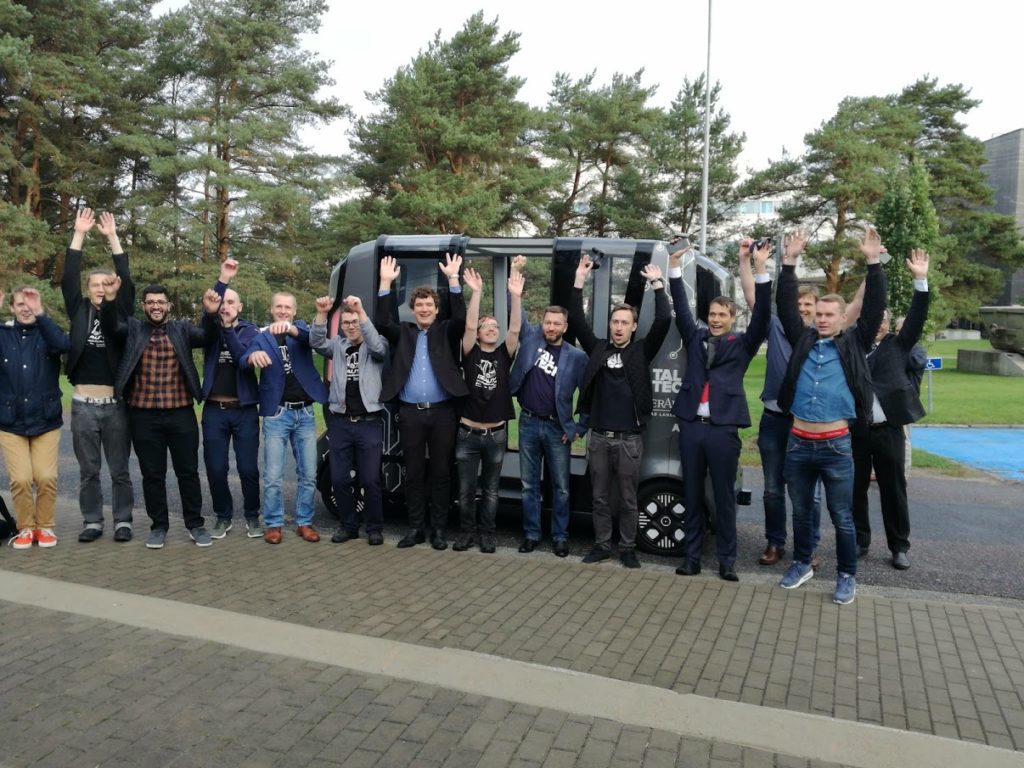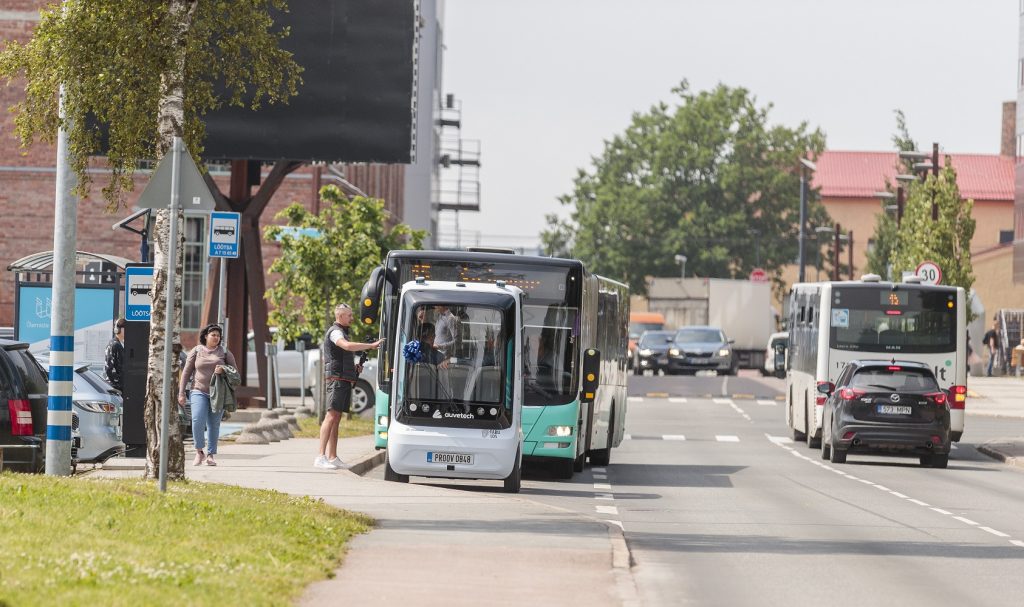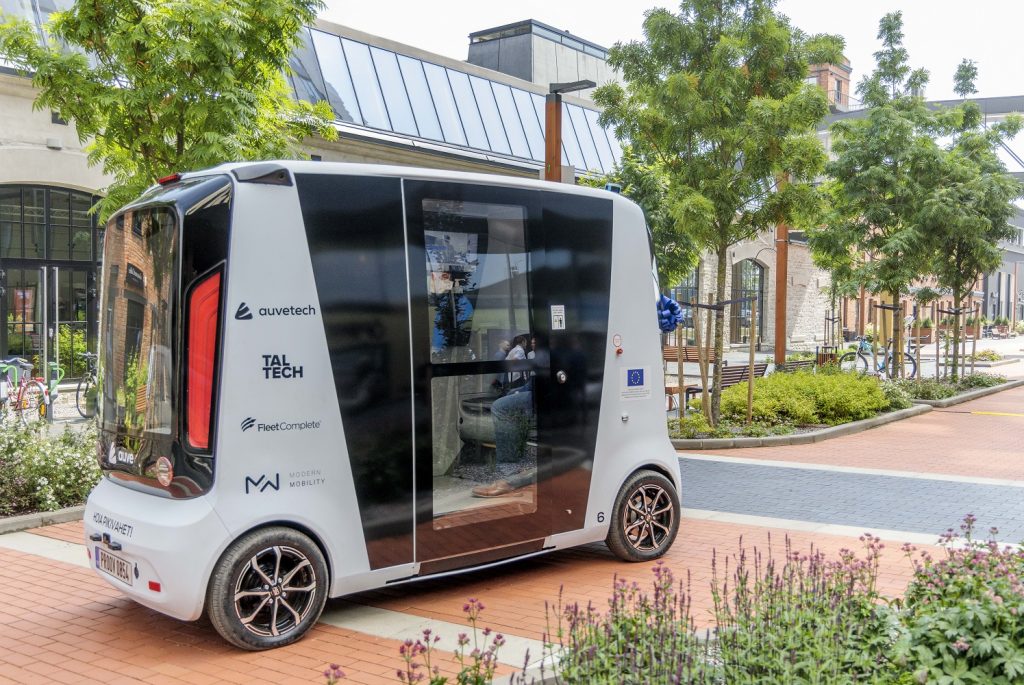The self-driving shuttle bus now officially in the streets of Tallinn emerged from a university robotics course.
This article is published in collaboration with Research in Estonia.
It feels like being in a giant toy car. There’s almost no sound, no steering wheel, no pedals, and, well, no driver either. Unless you consider the operator with a joystick a driver. For now, he has to come along for safety.
Next year, the plan is that, the operator won’t need to be there anymore. The bus will be monitored from a control centre. One person could oversee between three to ten buses and make sure everything runs smoothly.

Other than the maximum speed of 30 km/h (18.6 mph), the bus named Iseauto (“self-car” in English) doesn’t differ much from the other vehicles in Tallinn, the capital of Estonia. Officially, it is now part of the Estonian public transportation. Anyone can hop on and ride for free, because public transportation in Tallinn is free of charge for local residents.
Created by students and researchers
There are other automated shuttle buses like this one, but none of them have a story like that.
The original version of this vehicle was created with only €400,000 for the 100th birthday of Tallinn University of Technology – or in short, Taltech. Around 20 students and university researchers were given one year to make it happen.
The university had a long history with robotics and hence, enough confidence to pull this off.
Taltech had worked with mobile robots and autonomous systems for over two decades. It all started with a robotics course that ended up with a competition. And from that competition, the world’s biggest robotics festival emerged.

To speed up the process, the team built it on the open source software Autoware. But the pursuit for a different way of doing things didn’t end there. Most driverless vehicles are created by giant corporations with billion-dollar investments. As there is a lot at stake, they usually keep their black boxes strictly confidential, so it’s almost impossible for outsiders – even scientists – to work with them. Iseauto turned it around and for their own benefit.
“We only build everything on open sources,” said Raivo Sell, the head of the autonomous vehicles’ research team at Taltech and a senior research scientist. “We are completely open. Anyone can join us and test their software with our bus at any time.”
Taking the prototype into production and service
The bus was ready in a year just like promised. Jaak Aaviksoo, the rector of the university, hopped on and took the bus for a spin around the campus in 2018. Visitors took pictures and viewers stood in awe. That’s how the story could have ended.
“Universities are usually not interested in becoming a car producer or an engineering bureau,” Sell said. “We prefer to show how and what can be done and then move on.”
It was different with Iseauto. Some of the students who worked on the bus, graduated and started the company Auvetech to develop the vehicle into a product.
Mari-Ly Klaats was part of the Iseauto team in the university. After graduating, she joined Auvetech that now produces and sells Iseauto self-driving shuttles. “It was out of the question to leave the bus we made,” she said. “We decided to move on and develop the same product further.”

There are now ten Iseauto vehicles and five more coming in a few months. City councils that want to develop their smart city concepts around Europe reach out to them. Which city wouldn’t instantly look cooler with a self-driving bus? It’s the real buzzword these days. So much so that many university teams and companies exploit it.
The idea of a vehicle moving around on its own sounds attractive, but it’s still largely a science fiction material.
“We often see many ideas bounced around in festivals and events, but if you look closer, the vehicles themselves are still often just empty boxes,” Mari-Ly Klaats said. “In Estonia, we prefer to first make the actual product and then start selling it, not the other way around.”
Researching autonomous vehicles
In reality, even the biggest companies still require drivers to keep their hands on the steering wheel at all times because the automated vehicle technology barely works. They can still hardly get to the other side of the street. There have been enough accidents already.
And one of the people to have the guts – and enough knowledge – to say it out loud is professor Rahul Razdan, who runs a research group at Florida Polytechnic University.

His group is one of the very few that studies how to verify safety for automated vehicles. They are a step ahead from what most automated vehicles need to learn at this point.
In April 2019, Taltech and Florida Polytechnic University launched a partnership to research autonomous vehicles.
They look for interesting “edge cases” to use against the automated vehicle. For example, there is a truck with an ad on it picturing a woman. Should the vehicle stop for that, expecting the woman to be a real person and cross the street?
They study the language of driving and what the radars are able to pick up.
All very useful and literally a matter of life and death, but big companies carefully keep their proprietary internal designs to themselves and it’s difficult for scientists to work with them.
Hence, Razdan’s team found the Estonian research team to work with. The Estonian self-driving bus was the perfect choice because of its transparency policy. Iseauto is built by researchers, hence they are interested in developing and improving it without being afraid of criticism, which might be seen as bad publicity for a company.

And finally, the Estonian automated shuttle buses are already driving in real traffic, so the simulations that Razdan’s team runs can be based on real cases. They run the simulations in Florida and come back to the Estonian team with results. Some of the cases are played out in the streets of Tallinn, too.
Razdan calls Estonia a “city country” because of its size. This Northern European country only has 1.3 million people, so bureaucracy is not an issue the way it is in the United States.
A “driving exam”
This spring the self-driving buses were officially registered at the Estonian Road Administration. Auvetech wanted to get the buses on the streets by summer. Some of the Road Administration employees even postponed their holidays to speed up the process. And since it’s a completely new process, the government officials closely cooperated with the Iseauto team when coming up with the “driving exam”.
This is something difficult to imagine in most other countries.
The bus had to be adapted to the real vehicle requirements in the traffic. Among other changes and improvements, the windows, lights and the windshield wipers were changed.
The examiner made the bus stop, park and turn. To test its ability to detect danger, the examiners threw balls across the road for the bus to detect and covered the cameras with a blanket to see if it would stop. The automated vehicles are generally programmed to stop in case of any danger or uncertainty.
The bus passed the exam and received a licence plate.
There’s still a long road ahead for the Taltech team and for this startup, but their story shows not all science projects have to end with another forgotten PDF file. Some can end with unemployed bus drivers.

